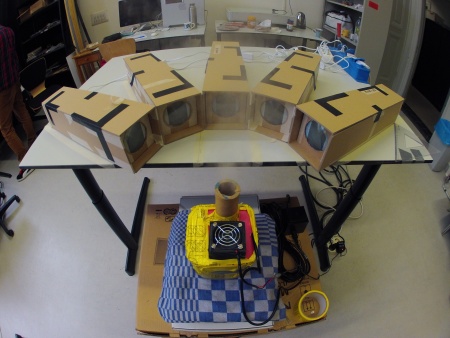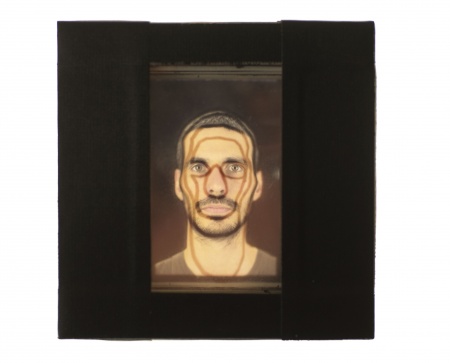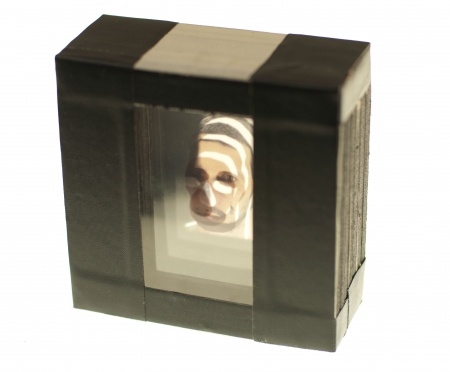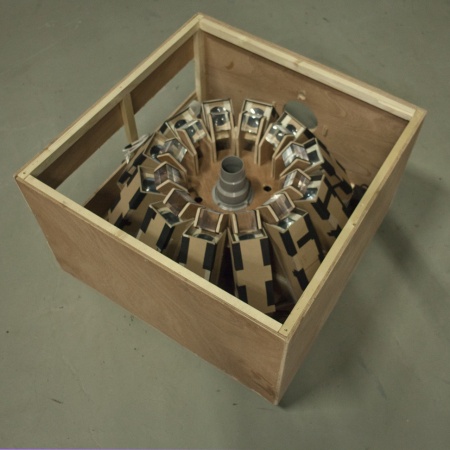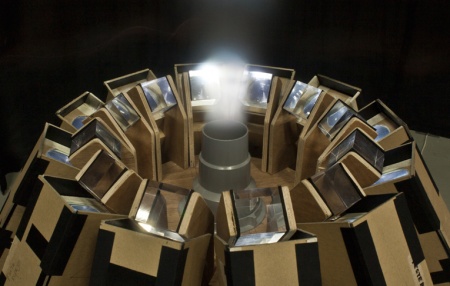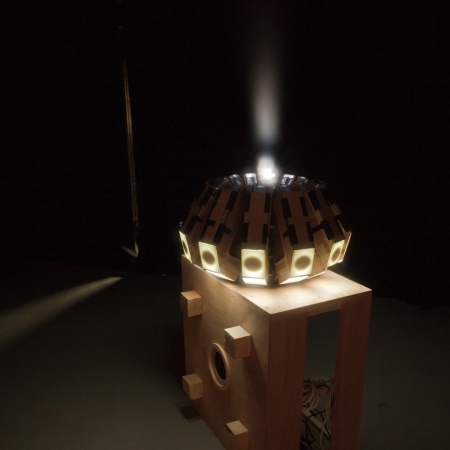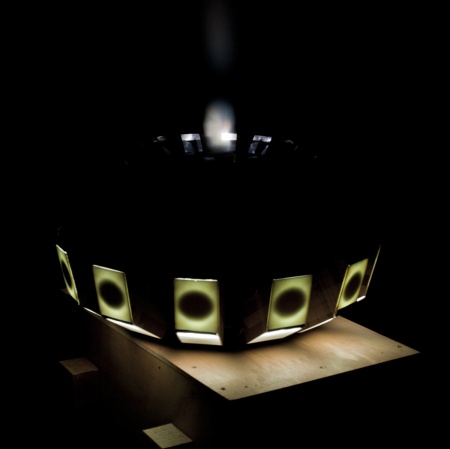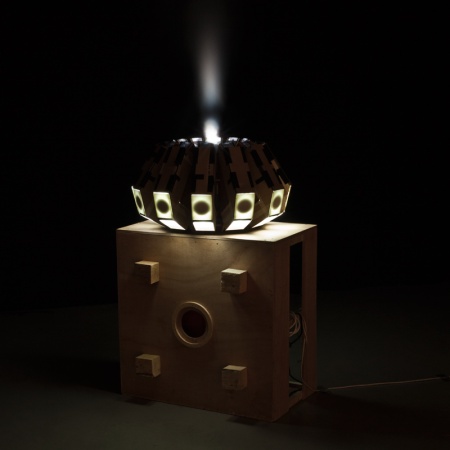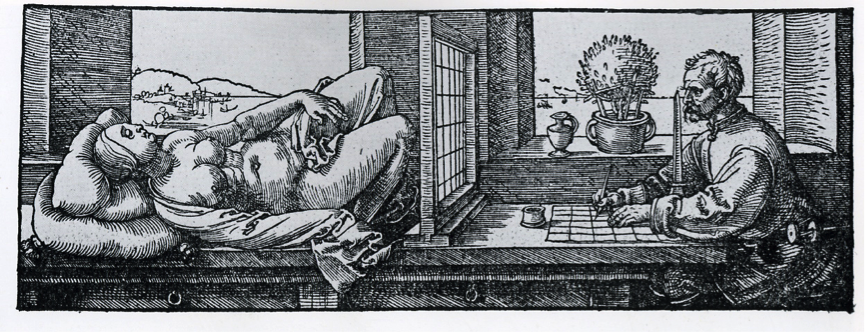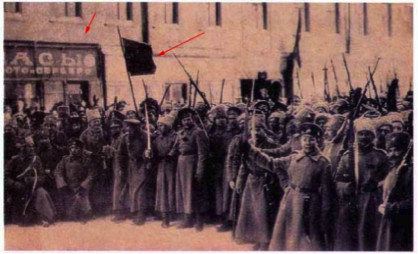User:Tomas Navarro/Graduation
TOMAS NAVARRO, Graduation Project. Piet Zwart Institute, Willem de Kooning Academy, 2012
truehologram
Description
True Hologram is a 3d display that forms a photorealistic volume in a high-saturated air medium (mist). True Hologram is a lens-based optical illusion that avoids any solid surface of projection, working exclusively with self-invented methodologies. True Hologram consequently pushes the audience to an extraordinary experience in imaging due to the singularity of its inherent features.
The project True Hologram is a research based on self- directed methodologies for the development of a sustainable, low-tech and artistically oriented 3d display outcome. The specific target to overcome is therefore 3d displays and widely holography, understood by me as technological boundary in the sociological-artistic panorama that will be removed soon through New Media artistic achievements. In order to explain correctly the reasons by which I devoted my study in how transcend the above-mentioned frontier in 3d images projection I must stand out the context in which this artwork has been developed and why I'm highlighting specifically holography as a limit (see chapter 2). This text will provide a better understanding of my personal role as images creator on the XXI century and why I aiming for sustainable and alternative 3D display technology in my process. New media could be widely synthesized as the collateral outcome of contemporary interaction with men and his environment, inevitably anchored on the ubiquitous technological context. Therefore society is embracing new numerical-based (digital) channels of communication as natural evolution of culture and mirroring them back as media production, closing perfectly the vitally process of self-expression and absorbency of culture.
Media
Video
Test footage, 24/04/2012 PZI Rotterdam
Download Quicktime H264 version
File:24042012test.mov.zip
Photos
Set up: Multi-angle projection (up to 5 beamers). Ultrasonic humidifier.
Source:multi-layered portrait, prototype.
Source: multilayered portarit, up to 5 angles.
DIYBeamer
360 final device
Essay
True Hologram is a lens-based and self-invented device that projects a photorealistic volume in a column of cold mist (I'm actually prototyping the device after successful tests). The device gathers DIY methodologies, smart/affordable approaches to 3d imaginery and re-adapted technology in order to achieve a floating volume formed just by casted light and photographic transparencies.
Far away from high-tech coordinates I managed to set up a DIY approach to photorealistic light sculpturing. True hologram is based on lenses, light transmission and simple achievements regarding 3d film processing and stereopsis. Holography is the process by which we could record the volume of any subject and then reproduce a 3D photographic representation of it. For many years the medium faced the unavoidable flat medium of screening; the volumetric images were formally a “multilayered photography”, a flat screen able to show different angles of an image and inevitably just an illusion of parallax. Widely defined by futuristic movies the holographic medium is still an unknown place for communication systems. Even if the last high-tech outcomes are able to fully depict a photorealistic 3d volume they cannot be touched; conceptually implies that they are caught in a certain ether or non-natural substance. Consequently I'm proposing a happy-tech device that, through basic re-adapted machinery, brings close to us the 3d displays (which nowadays are culturally still futuristic), using the methodologies of art and design; a hologram that can be touched.
PHOTOGRAPHIC AESTHETICS
EXTRACT_FROM_THESIS///
Hologram: 3D representation in photographic form.
The adjective photographic implies a realistic image, therefore a faithful record of the zoe , which is all the entities of our empiric experience (zoe, ζωή, life). Thus I’ll briefly explore why photography has been accepted as the objective tool for knowledge and communication and consequently established as orthodoxy on visual culture. Photography is strictly referred to the specific technology, able to faithfully mirror the empiric reality. However different reality projects were executed before, with the same function of mirroring and memorial permanence.
Nevertheless those reality projects never reached the scientific effectiveness of the photography, which its main differences are the objectivity, permanence and reproducibility of the images through the mechanic and chemical process. However both reality projects and photography share the same function: precise communication. They aimed to be empiric cognitive experiences but only photography was suitable for the scientific criteria of the modern era.
As medium (communication tool), the photography traces a specific axis in which its operates:
Zoe ---- Perception ---- Intention ---- Memory
We accept the photographic medium as a true testimony of our environment and history. Through the witness we agree on one immutable but accumulative culture, which is constantly re-shaping the zoe, perception of reality and the intention by which it’s observed. Therefore the above-depicted axis can be retraced as a circle (reality defines photo and photo re-defines reality). Thus, the core of the photographic medium is not the optical phenomena itself but the derived orthodoxy (and consequent heterodoxy): a social contract by which society agrees, by common sense, with specific semiotics related to the contextual visual culture. Please notice that I’m using the word orthodoxy, orthos (correct) doxa (opinion), which contrasts directly with a reasoned knowledge (ex: epistemology), therefore it is based in shared beliefs.
Although the photography is inevitably an applied science, his function as communication tool could or not fit in a rational scheme due to the subjectivity and permeability of the audience. History teaches us that many uses of it transcend in fact the apparent objectivity. The above-mentioned orthodoxy works, is credible, due to photography posses the same features of a mirror, adding the permanence and reproducibility. Instinctively we can trust on a photography as impermeable, perfect, even supernatural, mimesis. As premise: all the photographic medium serves to objectively depict the human activity and, culturally, we trust on it.
Therefore the function of the photography as medium is to mirror our concerns, shaping our culture within its coordinates of cognitive tool, which is also able to trespass our physiologic limitations and help us to record what is vanishingly small or immeasurably far away, thus magnifying the range of what is possible to measure (great concern of the scientific method). The content of photographic medium, independently of its purposes, is the reflection of our ideology in a specific social context and that defines the orthodoxy. On the other hand the motivation and intention by which photography is operated will define the level of compromise with the objectivity.
Thus, we can define two basic levels of compromise in photographic communication: the “realistic”, quotidian visual operations (objectivity), and the “meta-realistic”, which is the possibility of intervene the objectivity, for example, for artistic purposes.
Note: Susan Sontag regarding 11s.
Nevertheless the “meta-realistic” outcome needs to legitimize itself in order to be part of the same channel of communication. For example, a fake or visionary image needs to be legitimized as realistically possible; if it leaves the orthodoxy’s common sense it automatically becomes non legible and meaningless. In that sense we can deduce an immutable state of outcomes as we need to be anchored in a specific and contextualized space of ideas that could changes form but not content (culture). Thus, the evolution of ideas is basically a feedback that is not remarkably evolving but getting bigger and bigger, by incorporating the legitimized “meta-realistic” to the essentially immutable orthodoxy.

